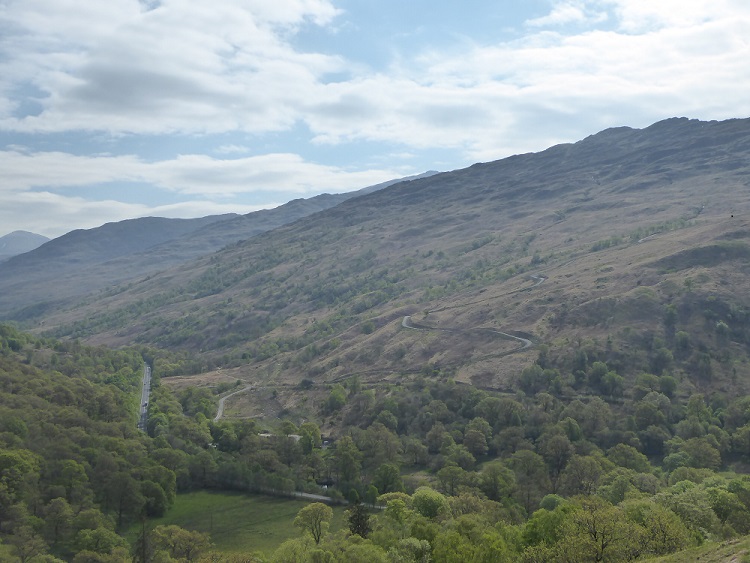
In March, a Planning Application (see here) was submitted to the Loch Lomond and Trossachs National Park Authority (LLTNPA) to add five new intakes to the Ben Glas run of river hydro scheme, above the Eagle Falls at the head of Loch Lomond. Parkswatch has covered this scheme before, (see here) and (here) for example, and argued it should have never been built.
Seven months and 89 documents after the latest application, there has not been a single comment from anyone except the statutory consultees, but still no decision. That is perhaps a positive thing, a sign that LLTNPA planners are at last starting to realise that their unconditional backing of hydro developments has in fact served to undermine the statutory purpose of our National Parks, which includes the need to address climate change. This post takes a look at the issues.
The reason for the application
Since the UK Government abolished the Feed In Tariff for run of river hydro schemes new developments have dried up. Hundreds of people who made a living out of the hydro rush, paid for by the public through higher electricity prices, have lost their jobs or had to move on to other work. A few are still involved in completing schemes such as the seven in Glen Etive which were granted planning approval just before the FIT was abolished.
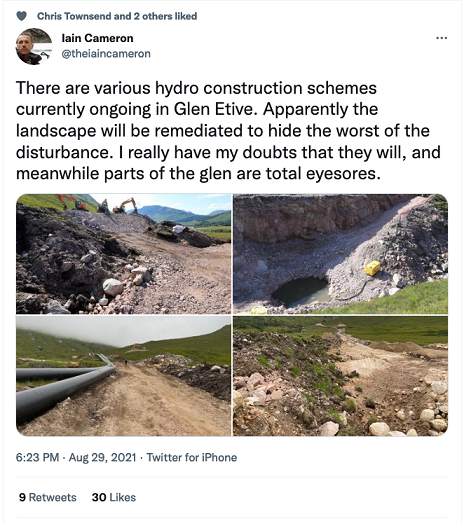
Others such as Gilkes Energy, the applicants in this case, have been clinging on in the greatly reduced market. Since new schemes are generally no longer profitable enough to find backers, attention has shifted to expanding existing schemes and channelling more water through existing turbine capacity. That is what is behind the Ben Glas proposal where:
“the extended scheme will remain at 1.3 MW, however the turbine will generate electricity for longer periods”.

The planning application is to create five new intakes, partially pre-fabricated out of steel rather than the usual concrete, and linked by over 1.5km of new plastic pipeline. Both the intakes and the pipes are small in size and will increase overall flow of water through the existing scheme by around 10%.
Ben Glas Power, the company that owns the Ben Glas hydro scheme is highly profitable. The scheme opened in September 2016, at which point its tangible assets were valued as £3,713,889 but, after its debt was taken into account, it was left with net assets valued as £2,444. Just four years later those net assets had increased to almost £2m:

As a small company, Ben Glas Power is exempt from providing details of its income and expenditure in it’s accounts, but the balance sheet (£1,924,256) indicates that, after operating expenses, it has made almost £500k profit a year since it started operation. All else being equal, by increasing the amount of water flowing through the turbine by 10%, the proposal before the LLTNPA would likely to increase those profits by 10% or £50k a year.
In short, this planning application, like almost every other run of river hydro scheme in Scotland (there are a few community exceptions), is primarily about making money.
Potential environmental impacts of the scheme
The landscape impact of the scheme is likely to be small from a distance (see photo above), particularly since no tracks, temporary or otherwise, are proposed. However, the intakes will impound pools that will silt up and need to be regularly excavated and this will have a local impact:
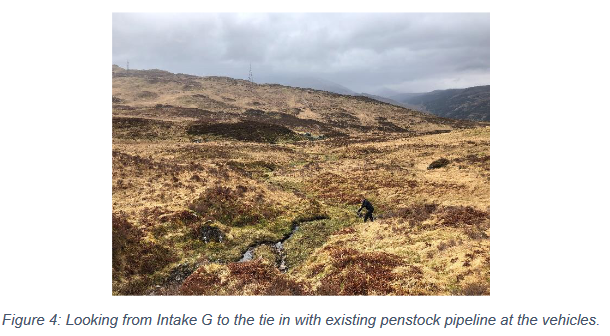
The Environmental Statement claims the impacts of impounding and diverting water will be benign but how many burns can you do this to before the hydrology, freshwater ecology and wider ecology of the entire area is affected? The Scottish Environmental Protection Agency in its response to the Planning Application declines to comment on this issue but does reveal that the LLTNPA’ “internal specialists” are looking at the “ecological and water environment matters associated with the project”. Parkswatch has been calling for this in respect of run of river hydro developments for some time, so its very welcome that LLTNPA ecologists are now considering the issues. Whether they will be allowed to advocate a precautionary approach in the absence of research is another matter.
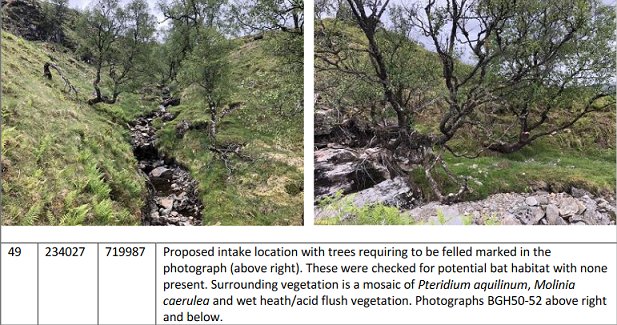
The carbon impact of the proposal
The Environmental Assessment states that “the diversion intakes will make a small but positive impact to climate change. However this chapter focuses on the impact climate change will have on the proposed development.” While it “anticipates” that the schemes will be able to withstand the sort of extreme weather events that caused severe damage to some of the existing Glen Falloch hydro schemes (see here), no evidence is provided to substantiate the first part of the claim.
The Environmental Statement avoids addressing the carbon impacts of the development, although it should be quite possible to calculate these. First there are the fossils fuels that will be used in the construction process and in fabricating the steel intakes. Second the concrete that will be used to secure the intakes and construct the wing walls. Third, there is the quantity of petrochemicals that will be needed to fabricate over 1.5km of polyethylene, i.e plastic, pipe. And fourth there is the quantity of peat that may be damaged by the construction of the pipeline.
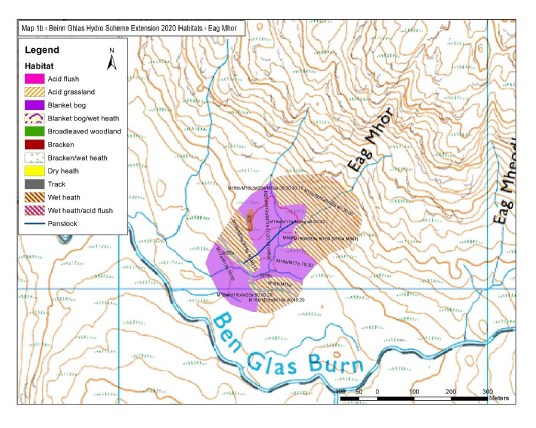
The vegetation survey submitted as part of the Environmental Statement shows that the developer proposes to install pipeline through an area of blanket bog (visible in photo above). The Scottish Government has prioritised the protection of blanket bog because of its importance as a carbon sink. Because of that there is now a policy presumption against planting trees on blanket bog and deep peat, although there is still a debate about what counts as deep (30cm or 50cm?).
The proposed pipeline will require peat and soil to be removed before being buried in a trench. This will result in some short-term peat loss but could also alter the hydrology of the bog leading to more extensive release of carbon into the atmosphere. How this is compatible with the peatbog restoration that the LLTNPA has been paying for just above the existing hydro intakes at Ben Glas is unclear.
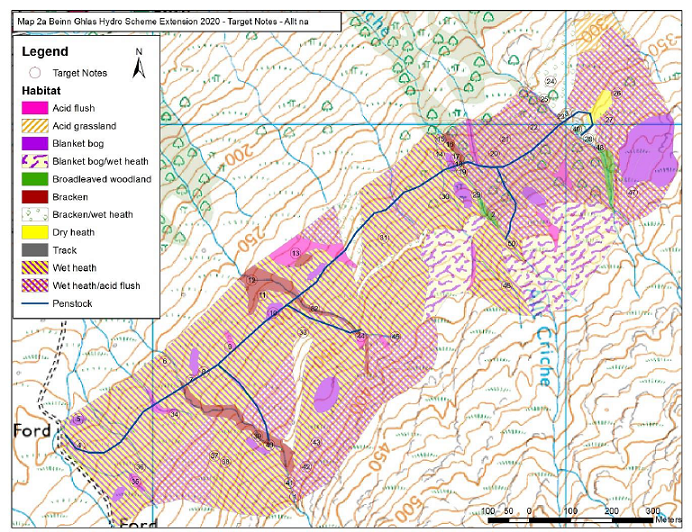
As the ecological survey states “most of the proposed route for the pipelines runs through extensive wet heath and Molinia caerulea [Purple Moor Grass] dominated wet heath habitat, with smaller areas of blanket bog occurring where the ground flattens, and peat has been able to accumulate”.
Wet heath too creates peat and indeed can be a forerunner to the formation of blanket bog but, as the ecological survey of the site shows, blanket bog can also develop on steep slopes:

The Construction Method Statement confirms that significant amounts of peat will be disturbed:
“Peat turves should be a minimum of 300mm thick. Peat turves for the pipeline will be replaced within two weeks of removal. Where turves cannot be reused immediately (for example from the immediate banks of the intakes, where they are permanently removed) they will be kept aside for use on restoration in similar areas.”
Despite this, the application makes no attempt to assess how carbon might be released into the atmosphere from burying the pipeline or how far it might impact on how peat accumulates here in future.
There are therefore very serious questions about the carbon impact of the proposed extension to the Ben Glas hydro and whether it will actually have any beneficial impact in terms of climate change. Consideration of that should be central to the decision about whether to approve or reject this application.
Who would benefit from the extension to this scheme?
The Planning Application reveals that “Ben Glas Power Ltd’s lease arrangements on the existing scheme will run for a further 36 years, after which ownership of the scheme is transferred to the landowner” while the accounts show that the company has a commitment “for future minimum lease payments” of £684,785. That is just under £20k a year that could, if the landowner decides, potentially be invested back into the local area. That amount could increase slightly as a result of the proposed extension and its possible the estate could take the opportunity to negotiate an increase in current rent payments.
While Ben Glas Power has no permanent employees locally – it and a number of other hydro schemes appear to be controlled from a centre in Paisley – it does use estate staff to maintain the scheme. That provides a fraction of a job in the local area. Apart from that, Ben Glas Power appears to have brought very little benefit to the local economy or to the National Park
The people who ultimately benefit from the £500k profits that derive from the FIT are hidden behind the usual web of companies through which the rich and powerful now operate. Gilkes Hydro Investments Ltd, which besides Ben Glas Power owns a cluster of hydro schemes in the Lake District, is owned by GHI Holdings Ltd. In December 2020 around 42% of GHI’s shares were bought by a company called Gravis Hydro Holdings Ltd, which is itself owned by Gravis Asset Holdings Ltd. In August 2021 Gravis Assets declared it was controlled by “Mourant Corporate Trustee (Jersey) Limited”, i.e owned by people whose interests are hidden in a tax haven.
Following the money through this dark web on the basis of information contained in company accounts, however, is an impossible task. What you can see, however, is that while the individual companies providing hydro power are financially sound and highly profitable, thanks to the FIT payments, those owning them are not.
GHI Holdings reported the financial position of it’s subsidiaries as follows in its accounts until September 2020 (see here):
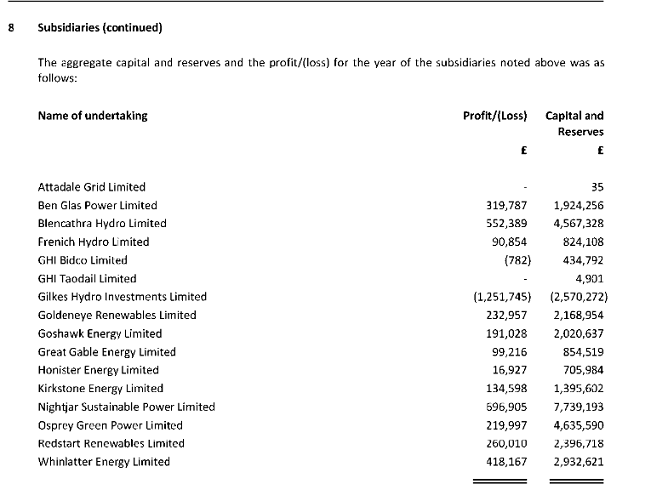
All except Gilkes Hydro Investments in a strong financial position. But in the same year GHI itself reported a loss of £198,072:

What explains the £8,915,548 in Administrative Expenses which appears to have wiped out the income from its subsidiaries? Where is that money, that is paid for us the public through FIT payments, going?
Move higher up the chain and the last accounts for Gravis Assets Holdings show a significant £15,996,000 loss (up from £2,346,000 the previous year):

How a company whose balance sheet records net liabilities of £18,841,000 managed to buy a controlling interest in GHI Holdings is unclear but then Highlands and Islands Enterprise failed to prevent a similar financial basket case of a company, Natural Assets Investment Ltd, from acquiring Cairngorm Mountain Ltd (see here).
The statement of going concern in the accounts also reveals that Gravis was being audited by Ofgem in relation to its entitlement to receive Renewable Energy Certificates:
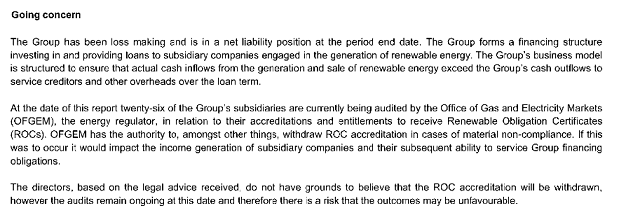
I can find nothing on the Ofgem website about the outcome of that audit, but the experience of the renewable heat incentive scheme in Northern Ireland (see here), reinforces the view that it is private financial greed, rather than any green intentions, which is driving renewable energy development.
What needs to happen
It is time the LLTNPA took a stand and assessed run of river hydro planning applications on their merits, instead of assuming that all renewable energy developments are good. Even if it can be shown that the proposed extension of the Ben Glas scheme will, during its expected lifetime, have a net positive impact on carbon emissions, questions should be asked about when the “green” electricity produced will offset the fossil fuels that will be used in its construction. Is waiting 20 years for a tiny scheme like this to start paying for itself in carbon terms worth it, given the risks and the other potential environmental impacts? Isn’t it time that the LLTNPA started to apply the precautionary principle to renewable energy developments in the National Park?
I might take a different view if the money that could be earned by this and other run of river hydro schemes was being invested in local communities or other green projects, paying for rural homes to be insulated,for example. But that is not on the agenda and, despite the spin, even the largest windfarms only offer tokenistic community benefits. The real money is being channelled out through the City.
Renewable energy development has been a lost opportunity in Scotland. Had we used pension funds, for example, to enable local communities and councils to develop hydro schemes – who would say no to 10% rates of return? – and had they gone to Scottish businesses for the parts, both rural and urban communities and the people of Scotland more generally might have benefited. Instead, both people and the environment lose, with the tacit consent of the political establishment.
Our National Parks should be different, they should be places which put nature and people first. Unfortunately, the LLTNPA Board has long delegated almost all planning decisions, including run of river hydro developments, to staff. With Board Members recently having spent three and half hours debating the merits of an 800m footpath in a Special Area of Conservation (see here), perhaps they could devote now a full day to considering the impacts of run of river hydro schemes? One would have thought that a 1.5km plastic pipeline through peat would merit that.
If enough people submit objections to this scheme (you can do so here), that might help force LLTNPA managers to refer the application to the Planning Committee for a decision.

Run of river sections of pipe stock to feed turbines are to be ‘concealed’ in the ground. It is clear that blanket peat only occurs when water flow has for many centuries become impeded by waterlogged and rotting vegetation. Natural depressions and hollows carved out by moving ice flow during the last Ice age and frost action since have “gifted” many regions where the bedrock has been broken away to much lower levels than those that surround it.
Subsequent to the retreat of ice a water-filled depression would have been left behind held between walls of permafrost ice or bedrock. ( Communities in high mountain regions of the world are now in danger as Ice caps retreat. Pools of glacial ice melt water are held trapped by ice and bedrock in such depressions.The Danger comes as Ice dams also melt, and unpredictable torrents of melt water can inundate narrow valleys ,where valley floor communities are vulnerable.) Such ancient ice lakes and ponds in Scotland are now peat bog.
When pipe-stock is laid across the soft ground, eventually a hard rock lip or ledge will be reached over which the pipe-stock must run. This would be above ground level? The alternative to a visible length of pipe-stock is for a trench to be carved by heavy machinery and rock drill blasting through which the pipe will fit. Even when such a trench is resealed with dams of concrete holding the pipe..such trenches carved through bedrock will then remain as a weak point, to compromise the drainage of the area above it for all time. This fresh drainage “slot” impact would be permanent.
In view of the expressed wish to preserve carbon trapped within peat, hillside boggy zones caused by poor drainage over millennia risk being left to dry out. Carving slots and pathways for trapped water to escape these bogs underground cannot be ignored. The Impact of laying “ecologically temporary” pipe downhill passing over or through harder bedrock ridges needs proper assessment. Now the real impacts on blanket bogs are better understood.The whole engineering concept must be properly addressed.